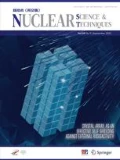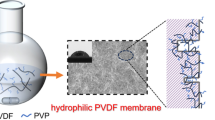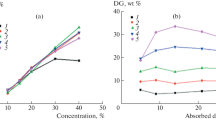Abstract
Membrane fouling is always the biggest problem in the practice of membrane separation technologies, which strongly impacts their applicability, separation efficiency, cost effectiveness, and service lifespan. Herein, a simple but effective 3D modification approach was designed for permanently functionalizing polymeric membranes by directly cross-linking polyvinyl alcohol (PVA) under gamma-ray irradiation at room temperature without any additives. After the modification, a PVA layer was constructed on the membrane surface and the pore inner surface of polyvinylidene fluoride (PVDF) membranes. This endowed them with good hydrophilicity, low adsorption of protein model foulants, and easy recoverability properties. In addition, the pore size and distribution were customized by controlling the PVA concentration, which enhanced the rejection ability of the resultant membranes and converted them from microfiltration to ultrafiltration. The cross-linked PVA layer was equipped with the resultant membranes with good resistance to chemical cleaning by acidic, alkaline, and oxidative reagents, which could greatly prolong the membrane service lifetime. Furthermore, this approach was demonstrated as a universal method to modify PVDF membranes with other hydrophilic macromolecular modifiers, including polyethylene glycol, sodium alginate, and polyvinyl pyrrolidone. This modification of the membranes effectively endowed them with good hydrophilicity and antifouling properties, as expected.








Similar content being viewed by others
References
X. Zhao, R. Zhang, Y. Liu et al., Antifouling membrane surface construction: chemistry plays a critical role. J. Membrane Sci. 551, 145–171 (2018). https://doi.org/10.1016/j.memsci.2018.01.039
V. Kochkodan, D.J. Johnson, N. Hilal, Polymeric membranes: Surface modification for minimizing (bio)colloidal fouling. Adv. Colloid Interface Sci. 206, 116–140 (2014). https://doi.org/10.1016/j.cis.2013.05.005
S.A. Deowan, F. Galiano, J. Hoinkis et al., Novel low-fouling membrane bioreactor (MBR) for industrial wastewater treatment. J. Membrane Sci. 510, 524–532 (2016). https://doi.org/10.1016/j.memsci.2016.03.002
S.H. Woo, J. Park, B.R. Min, Relationship between permeate flux and surface roughness of membranes with similar water contact angle values. Sep. Purif. Technol. 146, 187–191 (2015). https://doi.org/10.1016/j.seppur.2015.03.048
Z. Jiang, S. Karan, A.G. Livingston, Membrane fouling: does microscale roughness matter? Ind. Eng. Chem. Res. 59, 5424–5431 (2020). https://doi.org/10.1021/acs.iecr.9b04798
Y. Hu, Z. Lü, C. Wei et al., Separation and antifouling properties of hydrolyzed PAN hybrid membranes prepared via in-situ sol–gel SiO2 nanoparticles growth. J. Membrane Sci. 545, 250–258 (2018). https://doi.org/10.1016/j.memsci.2017.09.081
X. Tan, C. Hu, Z. Zhu et al., Electrically pore-size-tunable polypyrrole membrane for antifouling and selective separation. Adv. Funct. Mater. 29, 1903081 (2019). https://doi.org/10.1002/adfm.201903081
S. Ghiasi, A. Behboudi, T. Mohammadi et al., Effect of surface charge and roughness on ultrafiltration membranes performance and polyelectrolyte nanofiltration layer assembly. Colloids Surf. A 580, 123753 (2019). https://doi.org/10.1016/j.colsurfa.2019.123753
H. Jiang, Q. Zhao, P. Wang et al., Improved separation and antifouling properties of PVDF gravity-driven membranes by blending with amphiphilic multi-arms polymer PPG-Si-PEG. J. Membrane Sci. 588, 117148 (2019). https://doi.org/10.1016/j.memsci.2019.05.072
K.M. Dobosz, C.A. Kuo-LeBlanc, T. Emrick et al., Antifouling ultrafiltration membranes with retained pore size by controlled deposition of zwitterionic polymers and poly(ethylene glycol). Langmuir 35, 1872–1881 (2019). https://doi.org/10.1021/acs.langmuir.8b02184
J.H. Zuo, Y.H. Gu, C. Wei et al., Janus polyvinylidene fluoride membranes fabricated with thermally induced phase separation and spray-coating technique for the separations of both W/O and O/W emulsions. J. Membrane Sci. 595, 117475 (2020). https://doi.org/10.1016/j.memsci.2019.117475
Y. Zhao, X. Yang, L. Yan et al., Biomimetic nanoparticle-engineered superwettable membranes for efficient oil/water separation. J. Membrane Sci. 618, 118525 (2021). https://doi.org/10.1016/j.memsci.2020.118525
Z. Lin, C. Hu, X. Wu et al., Towards improved antifouling ability and separation performance of polyethersulfone ultrafiltration membranes through poly(ethylenimine) grafting. J. Membrane Sci. 554, 125–133 (2018). https://doi.org/10.1016/j.memsci.2018.02.065
Z.-Y. Liu, Q. Jiang, Z. Jin et al., Understanding the antifouling mechanism of zwitterionic monomer-grafted polyvinylidene difluoride membranes: a comparative experimental and molecular dynamics simulation study. ACS Appl. Mater. Interfaces 11, 14408–14417 (2019). https://doi.org/10.1021/acsami.8b22059
L. Han, Y.Z. Tan, C. Xu et al., Zwitterionic grafting of sulfobetaine methacrylate (SBMA) on hydrophobic PVDF membranes for enhanced anti-fouling and anti-wetting in the membrane distillation of oil emulsions. J. Membrane Sci. 588, 117196 (2019). https://doi.org/10.1016/j.memsci.2019.117196
R. Zhang, Y. Liu, M. He et al., Antifouling membranes for sustainable water purification: strategies and mechanisms. Chem. Soc. Rev. 45, 5888–5924 (2016). https://doi.org/10.1039/C5CS00579E
T.A. Trinh, W. Li, J.W. Chew, Internal fouling during microfiltration with foulants of different surface charges. J. Membrane Sci. 602, 117983 (2020). https://doi.org/10.1016/j.memsci.2020.117983
H. Sun, X. Yang, Y. Zhang et al., Segregation-induced in situ hydrophilic modification of poly(vinylidene fluoride) ultrafiltration membranes via sticky poly(ethylene glycol) blending. J. Membrane Sci. 563, 22–30 (2018). https://doi.org/10.1016/j.memsci.2018.05.046
J. Zhao, X. Zhao, Z. Jiang et al., Biomimetic and bioinspired membranes: Preparation and application. Prog. Polym. Sci. 39, 1668–1720 (2014). https://doi.org/10.1016/j.progpolymsci.2014.06.001
B. Wu, B. Zhang, J. Wu et al., Electrical switchability and dry-wash durability of conductive textiles. Sci. Rep. 5, 11255 (2015). https://doi.org/10.1038/srep11255
R.L. Clough, High-energy radiation and polymers: a review of commercial processes and emerging applications. Nucl. Instrum. Methods Phys. Res. Sect. B Beam Interact. Mater. Atoms 185, 8–33 (2001). https://doi.org/10.1016/S0168-583X(01)00966-1
S.-T. Ji, Q.-Q. Wang, J. Zhou et al., Synthesis of a Ag/AgCl/PLA membrane under electron beam irradiation for the photocatalytic degradation of methylene blue and chloramphenicol. Nucl. Sci. Tech. 31, 22 (2020). https://doi.org/10.1007/s41365-020-0726-8
X. Xu, X.-J. Ding, J.-X. Ao et al., Preparation of amidoxime-based PE/PP fibers for extraction of uranium from aqueous solution. Nucl. Sci. Tech. 30, 20 (2019). https://doi.org/10.1007/s41365-019-0543-0
M.M. Nasef, O. Güven, Radiation-grafted copolymers for separation and purification purposes: Status, challenges and future directions. Prog. Polym. Sci. 37, 1597–1656 (2012). https://doi.org/10.1016/j.progpolymsci.2012.07.004
J. Ye, B. Zhang, Y. Gu et al., Tailored graphene oxide membranes for the separation of ions and molecules. ACS Appl. Nano Mater. 2, 6611–6621 (2019). https://doi.org/10.1021/acsanm.9b01356
M.M. Nasef, E.-S.A. Hegazy, Preparation and applications of ion exchange membranes by radiation-induced graft copolymerization of polar monomers onto non-polar films. Prog. Polym. Sci. 29, 499–561 (2004). https://doi.org/10.1016/j.progpolymsci.2004.01.003
M.M. Nasef, S.A. Gürsel, D. Karabelli et al., Radiation-grafted materials for energy conversion and energy storage applications. Prog. Polym. Sci. 63, 1–41 (2016). https://doi.org/10.1016/j.progpolymsci.2016.05.002
J.H. O’Donnell, Radiation Chemistry of Polymers, in The effects of radiation on high-technology polymers. ACS Symposium Series, vol. 381, (American Chemical Society, 1989), pp. 1–13
J.S. Forsythe, D.J.T. Hill, The radiation chemistry of fluoropolymers. Prog. Polymer Sci. 25, 101–136 (2000). https://doi.org/10.1016/S0079-6700(00)00008-3
Y. Iwai, A. Hiroki, M. Tamada, Radiation-induced crosslinking of Nafion® N117CS membranes. J. Membrane Sci. 369, 397–403 (2011). https://doi.org/10.1016/j.memsci.2010.12.027
D. Rana, B.M. Mandal, S.N. Bhattacharyya, Miscibility and phase diagrams of poly(phenyl acrylate) and poly(styrene-co-acrylonitrile) blends. Polymer 34, 1454–1459 (1993). https://doi.org/10.1016/0032-3861(93)90861-4
D. Rana, K. Bag, S.N. Bhattacharyya et al., Miscibility of poly(styrene-co-butyl acrylate) with poly(ethyl methacrylate): existence of both UCST and LCST. J. Polym. Sci. Poly. Phys. 38, 369–375 (2000). https://doi.org/10.1002/(SICI)1099-0488(20000201)38:3%3c369::AID-POLB3%3e3.0.CO;2-W
J. Zhang, Z. Wang, Q. Wang et al., Relationship between polymers compatibility and casting solution stability in fabricating PVDF/PVA membranes. J. Membrane Sci. 537, 263–271 (2017). https://doi.org/10.1016/j.memsci.2017.05.041
K. Zhu, Y. Mu, M. Zhang et al., Mixed matrix membranes decorated with in situ self-assembled polymeric nanoparticles driven by electrostatic interaction. J. Mater. Chem. A 6, 7859–7870 (2018). https://doi.org/10.1039/C8TA00317C
P.H.H. Duong, S. Chisca, P.Y. Hong et al., Hydroxyl functionalized polytriazole-co-polyoxadiazole as substrates for forward osmosis membranes. ACS Appl. Mater. Interfaces 7, 3960–3973 (2015). https://doi.org/10.1021/am508387d
Y. Li, S. Huang, S. Zhou et al., Enhancing water permeability and fouling resistance of polyvinylidene fluoride membranes with carboxylated nanodiamonds. J. Membrane Sci. 556, 154–163 (2018). https://doi.org/10.1016/j.memsci.2018.04.004
B. Wang, M. Kodama, S. Mukataka et al., On the intermolecular crosslinking of PVA chains in an aqueous solution by γ-ray irradiation. Polym. Gels Netw. 6, 71–81 (1998). https://doi.org/10.1016/S0966-7822(98)00003-3
G. Beamson, D. Briggs, High Resolution XPS of Organic Polymers: The Scienta ESCA300 Database (Wiley, Chichester, 1992)
A. Qin, X. Li, X. Zhao et al., Engineering a highly hydrophilic PVDF membrane via binding tio2 nanoparticles and a PVA layer onto a membrane surface. ACS Appl. Mater. Interfaces 7, 8427–8436 (2015). https://doi.org/10.1021/acsami.5b00978
J.R. Du, S. Peldszus, P.M. Huck et al., Modification of poly(vinylidene fluoride) ultrafiltration membranes with poly(vinyl alcohol) for fouling control in drinking water treatment. Water Res. 43, 4559–4568 (2009). https://doi.org/10.1016/j.watres.2009.08.008
T. Montina, P. Wormald, P. Hazendonk, 13C solid-state NMR of the mobile phase of poly(vinylidene fluoride). Macromolecules 45, 6002–6007 (2012). https://doi.org/10.1021/ma3013477
H. Jang, D.H. Song, I.C. Kim et al., Fouling control through the hydrophilic surface modification of poly(vinylidene fluoride) membranes. J. Appl. Polym. Sci. 132, 41712 (2015). https://doi.org/10.1002/app.41712
J.M. Rosiak, Hydrogel dressings, in Radiation Effects on Polymers. ACS Symposium Series, vol. 475, (American Chemical Society, 1991), pp. 271–299
W. Chen, H. Bao, M. Zhang, Effect of gamma radiation on gelation in polyvinyl alcohol solutions. Radiat. Phys. Chem. 26, 43–47 (1985). https://doi.org/10.1016/0146-5724(85)90031-7
T.R. Dargaville, G.A. George, D.J.T. Hill et al., High energy radiation grafting of fluoropolymers. Prog. Polym. Sci. 28, 1355–1376 (2003). https://doi.org/10.1016/S0079-6700(03)00047-9
Y. Gu, H. Li, L. Liu et al., Constructing CNTs-based composite membranes for oil/water emulsion separation via radiation-induced “grafting to” strategy. Carbon 178, 678–687 (2021). https://doi.org/10.1016/j.carbon.2021.03.051
A. Lee, J.W. Elam, S.B. Darling, Membrane materials for water purification: design, development, and application. Environ. Sci. Water Res. Technol. 2, 17–42 (2016). https://doi.org/10.1039/C5EW00159E
Y. Zhao, J. Wen, H. Sun et al., Thermo-responsive separation membrane with smart anti-fouling and self-cleaning properties. Chem. Eng. Res. Des. 156, 333–342 (2020). https://doi.org/10.1016/j.cherd.2020.02.006
Y. Zhang, J. Wang, F. Gao et al., A comparison study: the different impacts of sodium hypochlorite on PVDF and PSF ultrafiltration (UF) membranes. Water Res. 109, 227–236 (2017). https://doi.org/10.1016/j.watres.2016.11.022
X. Yang, B. Zhang, Z. Liu et al., Preparation of the antifouling microfiltration membranes from poly(N,N-dimethylacrylamide) grafted poly(vinylidene fluoride) (PVDF) powder. J. Mater. Chem. 21, 11908–11915 (2011). https://doi.org/10.1039/C1JM11348H
S. Bhattacharjee, R. Kumar, K.S. Gandhi, Modelling of protein mixture separation in a batch foam column. Chem. Eng. Sci. 56, 5499–5510 (2001). https://doi.org/10.1016/S0009-2509(01)00156-7
M.F. Rabuni, N.M. Nik Sulaiman, N. Awanis Hashim, A systematic assessment method for the investigation of the PVDF membrane stability. Desalin. Water Treat. 57, 1–12 (2016). https://doi.org/10.1080/19443994.2015.1012336
X. Ding, M. Yu, Z. Wang et al., A promising clean way to textile colouration: cotton fabric covalently-bonded with carbon black, cobalt blue, cobalt green, and iron oxide red nanoparticles. Green Chem. 21, 6611–6621 (2019). https://doi.org/10.1039/C9GC02084E
C. Yang, G. Wu, Chapter Four—Radiation Cross-Linking for Conventional and Supercritical CO2 Foaming of Polymer, in Radiation Technology for Advanced Materials. ed. by G. Wu, M. Zhai, M. Wang (Academic Press, 2019), pp. 115–139
Y. Gu, Y. Qiao, Y. Meng et al., One-step synthesis of well-dispersed polypyrrole copolymers under gamma-ray irradiation. Polym. Chem. 12, 645–649 (2021). https://doi.org/10.1039/D0PY01566K
Acknowledgements
The authors would like to thank Prof. Wan-Zhong Lang and his group from Shanghai Normal University for their enthusiastic help and support for the characterization of membranes, and they also have pleasure in acknowledging the support from the Shanghai Engineering Research Centre of Green Energy Chemical Engineering.
Author information
Authors and Affiliations
Contributions
All authors contributed to the study conception and design. Material preparation, data collection and analysis were performed by Yu Gu and Bo-Wu Zhang. The first draft of the manuscript was written by Yu Gu and all authors commented on previous versions of the manuscript. All authors read and approved the final manuscript.
Corresponding authors
Additional information
This work was supported by the National Natural Science Foundation of China (Nos. 11875313, 12075153, and 11575277).
Supplementary Information
Below is the link to the electronic supplementary material.
Rights and permissions
About this article
Cite this article
Gu, Y., Zhang, BW., Guo, Z. et al. Radiation-induced cross-linking: a novel avenue to permanent 3D modification of polymeric membranes. NUCL SCI TECH 32, 70 (2021). https://doi.org/10.1007/s41365-021-00905-y
Received:
Revised:
Accepted:
Published:
DOI: https://doi.org/10.1007/s41365-021-00905-y




